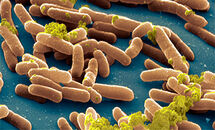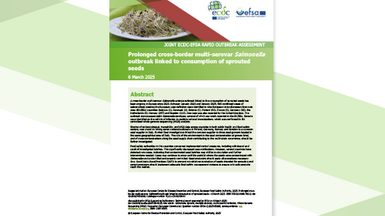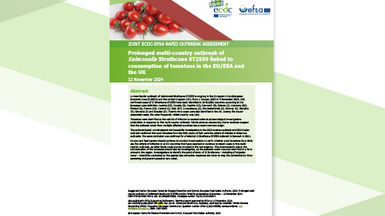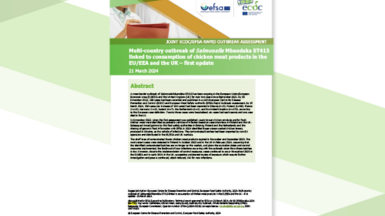Rapid outbreak assessment: multi-country outbreak of Salmonella Enteritidis phage type 8, MLVA profile 2-9-7-3-2 and 2-9-6-3-2 infections, 7 March 2017
A multi-country outbreak of Salmonella Enteritidis phage type 8 with MLVA profiles 2-9-7-3-2 and 2-9-6-3-2, linked to eggs, is ongoing in the EU/EEA. Based on whole genome sequencing, isolates are part of two distinct but related genetic clusters. ECDC and EFSA are liaising with relevant authorities in the Member States and the European Commission to facilitate the coordination of investigation and response measures.
Annexes 2a and 2b are available as separate downloads (PDF) below.
Executive Summary
The rapid outbreak assessment from ECDC and EFSA shows that from 1 May 2016 to 24 February 2017, 14 EU/EEA countries reported 218 confirmed cases of Salmonella Enteritidis phage type (PT) 8, with multiple locus variable-number tandem repeat analysis (MLVA) profiles 2-9-7-3-2 and 2-9-6-3-2, linked to eggs, and belonging to two distinct WGS clusters. Two hundred and fifty-two probable cases shared the S. Enteritidis MLVA profiles 2-9-7-3-2 or 2 9 6 3 2.
The outbreak peaked at the end of September 2016, shortly before the vehicle of infection was identified and control measures were implemented at farm and distribution level. Since then, the number of cases with the outbreak types of S. Enteritidis has steadily decreased: two or fewer new cases per week were reported in January and in the first week of February 2017.
Available evidence from epidemiological, microbiological, environmental and tracing investigations identified eggs originating from three Polish packing centres as the vehicle of infection in this outbreak. Investigations in the farms identified 18 S. Enteritidis-positive laying hen farms in Poland. Most of these positive farms, as well as the three packing centres, belong to the same Polish consortium and therefore are considered to be interlinked.
According to the information provided by Polish authorities, no S. Enteritidis-positive breeding flock was detected in 2016. Based on the current evidence, the source of infection of this outbreak is likely to be at the laying hen farm level. However, due to the structure of egg production there is the possibility that S. Enteritidis might have entered at a higher level in the food chain. Therefore, it is recommended that the Polish authorities further check the S. Enteritidis status of the hatcheries and breeding flocks, especially those linked to the positive farms.
In addition to the restrictive measures already in place, it is recommended that all appropriate measures aiming at reducing the risk of Salmonella contamination at laying hen farm level are thoroughly applied by Poland.
New cases and critical developments should be reported to EPIS-FWD (Epidemic Intelligence Information System for Food- and Waterborne Diseases and Zoonoses) by the appropriate authorities.
Download

Publication data
Data
Annex 2a: Single nucleotide polymorphism (SNP)-based phylogenetic trees of S. Enteritidis isolates
from Belgium, Croatia, Denmark, Finland, France, Hungary, Italy, Luxembourg, the Netherlands, Norway, Poland, Slovenia, Sweden, and the United Kingdom. SNP address 1.2.3.175.% (N=249)
Data
Annex 2b: SNP-based phylogenetic trees of S. Enteritidis isolates
from Belgium, Croatia, Denmark, Finland, France, Hungary, Italy, Luxembourg, the Netherlands, Norway, Poland, Slovenia, Sweden, and the United Kingdom. SNP address 1.2.3.175.% (N=249)







